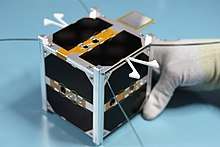Slovak Organisation for Space Activities
Slovak Organization for Space Activities - SOSA (Slovak: 'Slovenská organizácia pre vesmírne aktivity') is non-governmental organization based in Bratislava, Slovakia that promotes space-related research and technologies nationally.[1] The organization supports Slovak activities with the European Space Agency (ESA) and the European Southern Observatory (ESO), developed skCUBE, the first Slovak satellite, and organizes events to promote space-related research and industry.

Goals
SOSA promotes space-related research and technologies within the Slovak Republic. Its members include specialists, professionals and students. SOSA has used meteorological balloons to perform experiments at the edge of space. It organises space-themed educational projects and competitions and enabled students to work on the development of its first probe skCube.

Projects
Stratospheric Balloon - skBalloon
SOSA's first project started in 2008, sending meteorological balloons to the stratosphere. The project was named skBalloon. Its goal was to develop a re-usable probe that could be flown to near-space, an altitude of 35–40 km, with a payload of technical experiments. The project became a commercial venture in 2013 under the company name GoSpace.
First Slovak Satellite - skCUBE
skCube is SOSA's project to design, construct, launch, operate and analyze data from CubeSat 1U. The satellite is 10x10x10cm in size and weighs 1056g. Slovak specialists participated in the development of Magion class satellites in the 1970s and space probes have components built in Slovakia. The goal was to launch a probe which will be designed, constructed and managed from Slovakia, which would be the country's first satellite launched since independence in 1993. The satellite was successfully launched onboard PSLV rocket from Sriharikota, India on June 23, 2017.
References
- "Horizon 2020 Space Information Day". Retrieved 2016-08-23.
External links
- Evidence of Civil Associations [online]. Ministry of Interior of the Slovak Republic, [2013-01-05] Available online
- Primary website: http://sosa.sk/
- skCube website: http://www.skcube.sk/
- Articles about astronautics: http://www.kozmonautika.sk/
- Slovakian discussion forum about astronautics: http://forum.kozmonautika.sk/